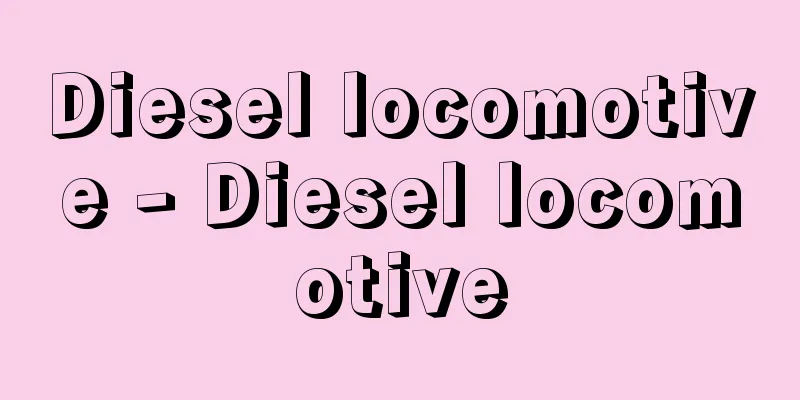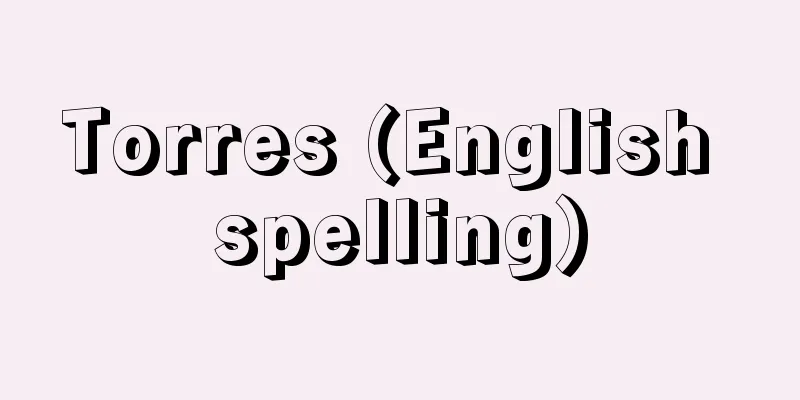Diesel locomotive - Diesel locomotive

|
A locomotive powered by a diesel engine. Structure and typesIt consists of the engine, cooling system, power transmission system, car body, and bogie. The engine must be small, lightweight, and have high output, and most have a rotation speed between medium and high speed, around 1000 to 1500 revolutions per minute. There are three types of power transmission: mechanical, hydraulic, and electric. (1) Mechanical type: This type uses gears to reduce speed and a clutch to change the gear ratio. It was used in early small locomotives. It is lightweight, has a simple structure, and has good power transmission efficiency, but since it uses a clutch, it is not suitable for large horsepower engines. Due to the shock when switching and the difficulty of controlling multiple units, there are few mechanical types used for commercial purposes today. (2) Hydraulic: This system uses a hydraulic transmission that combines a gear mechanism and a torque converter to change the drive torque according to the speed. It allows for smooth speed changes and is suitable for engines with low to high horsepower (approximately 2000 horsepower). Most of the diesel locomotives of the former Japanese National Railways and JR were of this hydraulic type. In Germany, Mekydro-Maybach hydraulic diesel locomotives were widely used by the West German Federal Railways and were also widely exported to other countries. (3) Electric type: This is a system in which the onboard diesel engine rotates a generator, and the generated electricity drives a motor. In other words, it is an electric locomotive with a generator built into the vehicle itself. It is convenient for overall control when two or more locomotives are connected, and switching is smooth and maintenance is easy. In Japan, it was adopted for the DF50 type in 1957 (Showa 32), when large diesel locomotives were introduced. In continental countries such as the United States, the former Soviet Union, and China, the length of railway trunk lines is long, and electrification of the entire line is difficult, so electric diesel locomotives that use the locomotive itself as a power plant were adopted when modernizing the power source from steam locomotives. Therefore, the electric type is the most widely used worldwide. In the United States, completely smokeless domestic railways were achieved in 1950 with diesel electric locomotives (called DEL in the United States). Electric types are divided into direct current and alternating current types depending on the generator. Previously, DC locomotives were popular, mainly in the United States, but with the advancement of control electronic devices, a system combining AC generators, converters, and induction motors has become mainstream since the 1990s, and has surpassed the liquid type. As the liquid type DD51 type has become old, JR Freight has been manufacturing the electric type DF200 type for Hokkaido since 1992 to replace it. Also, hybrid locomotives, which are diesel-electric locomotives equipped with large-capacity storage batteries, have been put to practical use in the United States and Canada, aiming to improve energy efficiency and reduce noise. When high output is required, such as at start-up, power is supplied from the storage battery, and the output of the engine itself is reduced. In Japan, JR Freight built a prototype HD300 hybrid locomotive in 2010, and has been mass-producing it since 2012. Diesel engines for locomotives have developed into two-stroke engines in America and four-stroke engines in Europe. In Japan, four-stroke engines are mainly used. There are many different types, with the number of cylinders ranging from 6 to 18, and the arrangement can be in-line, V-shaped, horizontally opposed, in-line opposed, etc. The fuel is diesel oil, which meets the JIS K2204 standard in Japan, and the lubricant is internal combustion oil JIS K2215. As emission regulations for diesel engines are becoming stricter in each country, fuel control is also carried out in a detailed manner by computer. [Gentaro Nishio and Yoshihiko Sato] History and current situationIt is said that diesel locomotives were made in Germany in 1912. At first, like steam locomotives, large wheels were driven by rods, but they developed into their current form through the development of unique technologies. The diesel locomotives of Japan's national railway began in 1929 (Showa 4) and 1930, when the Ministry of Railways acquired one each as compensation for World War I. The DC10 type was a mechanical type with gear reduction, and the DC11 type was an electric type, and they were valuable samples for mechanical and railway vehicle engineers at the time. There was a worldwide trend away from steam locomotives and toward diesel and electrification, and in Japan, in 1933, the South Manchuria Railway planned to adopt a 750 horsepower electric diesel locomotive, and manufacturers such as the Japan Railway Company, Hitachi, Toshiba, and Niigata Iron Works proceeded with development in an attempt to catch up with the world's technological standards. In 1935, Kawasaki Sharyo Co. manufactured one electric diesel locomotive, the DD10 type. The engine was a 500 horsepower 8-cylinder engine manufactured by Niigata Iron Works, with an A1A/A1A axle arrangement, which was rare at the time, and was deployed at Oyama Locomotive Depot for the Ryomo Line. However, due to the lack of oil resources from the Second Sino-Japanese War in 1937 until Japan's defeat in World War II, the development of railway vehicles using internal combustion engines was suspended. The manufacture of diesel locomotives resumed in Japan in 1951 (Showa 26). In that year, a technical partnership was formed with the Swiss company Salzer, and the DD50 type, which was based on a domestically produced 8-cylinder 4-stroke engine, was manufactured by Shin Mitsubishi Heavy Industries (now Mitsubishi Heavy Industries) and completed in 1953. From this time on, various companies began to prototype various diesel locomotives and tests were conducted on the JNR main line, and the standard type was the electric DF50 type for main lines from 1957, and the hydraulic DD13 type for shunting from 1958. In addition to the partnership with Salzer, the DF50-type main engine was equipped with a domestically produced V12 1,400 horsepower engine in partnership with MAN of Germany. The first large main line diesel locomotive made entirely with domestic technology was the DD51, introduced in March 1962. It was a hydraulic central cab convex locomotive equipped with two 1,100 horsepower DML61 engines, and was used as the main diesel locomotive of JNR for both passenger and freight on non-electrified sections, and is still used by JR for freight. The DE10 for branch lines is also hydraulic, equipped with one DML61 engine, and was mass-produced from 1966 as an improved version of the DD13. In addition, snow removal work was previously carried out by coupling dedicated snowplows such as russells, rotary and wide-width snowplows to steam locomotives, but to streamline work and increase capacity, self-propelled snowplows with snow removal capabilities added to the DD13, DD51, DE10 and DD16 diesel locomotives have been manufactured since 1970. When modernizing railroad motive power, a huge initial investment is required for electrification equipment, but diesel locomotives can achieve smokeless operation and modernization of motive power simply by replacing steam locomotives. In continental countries, where the tracks are long and the investment in electrification equipment is huge, and it is difficult to supply electricity, diesel locomotives are indispensable. However, in a country like Japan, where the length of tracks is short and the number of passengers is large, electrification is advantageous in the long run in terms of operating costs such as vehicle repair costs and power costs. Therefore, electrification has been the mainstream in the modernization of railway power in Japan, and diesel locomotives were only used temporarily until electrification was completed. Due to a decrease in freight transport volume and the replacement of passenger trains with diesel railcars, the number of diesel locomotives of the former JNR, which peaked at 2,207 at the end of March 1978, decreased to 494 at the end of 2002 (Heisei 14) after the transfer to JR, and has been on a downward trend since then. Globally, the number is increasing in North America, Asia and Oceania, where there are many non-electrified freight railways. [Gentaro Nishio and Yoshihiko Sato] "100 Years of JNR Vehicles" (1974, Koyusha), edited by Japan National Railways ; "JNR Diesel Locomotive Guidebook" (1976, Seibundo Shinkosha), written by Terayama Iwao [Reference] | | | | | |©Toshihisa Watanabe "> Structure of diesel locomotive (DD51 type) Source: Shogakukan Encyclopedia Nipponica About Encyclopedia Nipponica Information | Legend |
|
ディーゼルエンジンを動力源とする機関車。 構造と種類エンジン本体、冷却装置、動力伝達装置、車体、台車から構成される。エンジンは小型・軽量と高出力が要求され、毎分1000回転から1500回転程度の中速と高速の中間の回転数のものが多い。動力伝達方式には、機械式、液体式、電気式の3方式がある。 (1)機械式 歯車によって減速し歯車の比率をクラッチで切り換える方式で、初期の小型機関車に使用された。軽量で構造が簡単であり、動力伝達効率もよいが、クラッチを使うので大馬力のエンジンには適さず、切換え時のショックや重連総括制御の困難から、現在では、営業用として使用されているものは少ない。 (2)液体式 歯車機構とトルクコンバーターを組み合わせた液体変速機によって駆動トルクを速度に応じて変化させる方式である。速度の変化がスムーズで小馬力から大馬力(2000馬力程度)までのエンジンに適する。日本の旧国鉄およびJRのディーゼル機関車は大部分がこの液体式である。ドイツでもメキドロ・マイバッハMekydro-Maybach式の液体式ディーゼル機関車が西ドイツの連邦鉄道で多く使用され、外国にも広く輸出された。 (3)電気式 搭載したディーゼルエンジンで発電機を回し、発生した電力でモーターを駆動する方式である。いわば発電装置を車両自体に備えた電気機関車である。機関車を2台以上連結しての総括制御に便利で切換えもスムーズ、保守も容易である。日本では大型ディーゼル機関車導入期の1957年(昭和32)にDF50形などに採用された。アメリカ、旧ソ連、中国などの大陸諸国は鉄道幹線の延長距離が長く、全線の電化が困難であることから、蒸気機関車からの動力近代化にあたって、機関車自体を発電所とする電気式ディーゼル機関車が採用された。したがって世界的には電気式がもっとも広く使われている。アメリカでは1950年に国内鉄道の完全無煙化をディーゼル電気機関車(アメリカではDiesel electric locomotive、DELとよぶ)で達成した。電気式には発電機によって直流式と交流式がある。従来はアメリカを中心に直流式が普及してきたが、制御電子機器の進歩に伴って、1990年代以降、交流発電機、コンバーターおよび誘導電動機を組み合わせた方式が主流となり、液体式を凌駕(りょうが)している。液体式のDD51形が古くなったので、その置き換え用として、JR貨物が北海道用に1992年から製造しているDF200形は電気式である。 また、エネルギー効率向上と騒音低減をねらい、電気式ディーゼル機関車に大容量蓄電池を搭載したハイブリッド機関車が、アメリカ、カナダで実用化されている。起動時などの大出力が必要なときは蓄電池からもパワーを供給して、エンジンそのものの出力を小さくしている。日本でもJR貨物が、2010年(平成22)にHD300形ハイブリッド機関車を試作し、2012年から量産している。 機関車用のディーゼルエンジンは、アメリカでは2サイクル、ヨーロッパでは4サイクル方式で発達してきた。日本では主として4サイクルエンジンが採用されている。型式も多様で、シリンダー数は6から18、配列も直列、V字、水平対向、直列対向などがある。燃料はディーゼル軽油で、日本ではJIS(ジス)K2204規格が使われ、潤滑油は内燃機油JISK2215である。各国でディーゼル機関の排出ガス規制が強化されつつあることから、燃料制御もコンピュータによりきめ細かく行われている。 [西尾源太郎・佐藤芳彦] 沿革と現況ディーゼル機関車は1912年にドイツでつくられたといわれている。最初は蒸気機関車のように大きな動輪をロッドで駆動していたが、独自の技術の発達によって現在の型状に発展した。日本の国鉄のディーゼル機関車は、1929年(昭和4)と1930年、第一次世界大戦の賠償物資として1両ずつが鉄道省に取得されたことに始まる。DC10形は歯車減速の機械式、DC11形は電気式で、当時の機械・鉄道車両技術者にとっては貴重なサンプルであった。世界的に蒸気機関車からディーゼルや電化に向かう気運が盛んになり、日本でも1933年には当時の南満州鉄道に750馬力の電気式ディーゼル機関車の採用が計画され、汽車会社、日立製作所、東芝、新潟鉄工所などの製造会社は世界の技術水準に追随しようと開発を進めた。1935年、川崎車輌(しゃりょう)会社は電気式ディーゼル機関車DD10形1両を製造した。エンジンは新潟鉄工所製の8気筒500馬力、当時としては珍しいA1A・A1Aの軸配置で、両毛線用として小山機関区に配置された。しかし、1937年の日中戦争から第二次世界大戦敗戦まで石油資源の欠乏から、内燃機関を使用する鉄道車両の開発は中断された。ディーゼル機関車の製造が日本で再開されたのは1951年(昭和26)である。この年、スイスのザルツァー社との技術提携が行われ、国産化された8気筒4サイクルのエンジンを主機としたDD50形を新三菱重工業(しんみつびしじゅうこうぎょう)(現・三菱重工業)で製造、1953年に完成させた。このころから各種のディーゼル機関車を各社が試作して国鉄本線でのテストも行われ、標準型式として本線用は電気式のDF50形が1957年から、入換え用は液体式のDD13形が1958年から生産された。DF50形の主基機関にはザルツァー社との提携のほかに、ドイツのマン社とも提携してV型12気筒1400馬力エンジンも国産化され、搭載された。 純国産技術による大型幹線用ディーゼル機関車は1962年3月のDD51形である。1100馬力のDML61形2基を搭載する液体式中央運転室凸形機関車で、国鉄の主力ディーゼル機関車として非電化区間の客貨両用に使用され、現在もJRで貨物用として使われている。支線区用のDE10形は同じくDML61形エンジン1基を搭載する液体式で、DD13形の改良型として1966年から量産された。また、除雪作業には従来ラッセル、ロータリー、広幅などの専用除雪車を蒸気機関車に連結して推進していたが、作業の合理化と能力増強のため、DD13形、DD51形、DE10形、DD16形のディーゼル機関車に除雪機能を付加した自走式除雪機関車が1970年以降製造された。 鉄道動力の近代化を図るとき、電化設備には多大な当初の投資が必要であるが、ディーゼル機関車は蒸気機関車と置き換えるだけで無煙化と動力近代化が達成できる。大陸諸国のように線路が長く電化設備投資が膨大に上り電力の供給も困難な場合には、ディーゼル機関車が不可欠となっている。 しかし、日本のような線路延長が短く旅客数の多い国では、車両修繕費や動力費などの運転経費の面では、長期的には電化が有利である。したがって日本の鉄道動力近代化は、電化が主流で、ディーゼル機関車は電化完成まで過渡的に使用されたにとどまる。貨物輸送量の減少、旅客列車のディーゼル動車への置き換えにより、ピーク時の1978年3月末に2207両だった旧国鉄のディーゼル機関車は、JR移管後の2002年(平成14)末には494両に減少し、その後も減少傾向にある。世界的には、非電化貨物鉄道の多い北アメリカ、アジア・オセアニアで増えている。 [西尾源太郎・佐藤芳彦] 『日本国有鉄道編『100年の国鉄車両』(1974・交友社)』▽『寺山巖著『国鉄ディーゼル機関車ガイドブック』(1976・誠文堂新光社)』 [参照項目] | | | | | |©渡部利久"> ディーゼル機関車の構造(DD51形) 出典 小学館 日本大百科全書(ニッポニカ)日本大百科全書(ニッポニカ)について 情報 | 凡例 |
Recommend
Imazighen
〘Noun〙 (Imazighen, plural of "Amazigh", ...
Automobile
...Also, the Shuto Expressway and the Hanshin Exp...
Richelieu
…At the command of Louis XIII, he enlarged the Lo...
Society - Seken
〘Noun〙① Buddhist language. (I) (A translation of l...
Norwich School of Painting
A school of British provincial painting in the ear...
mucin
…The secretion rate increases after eating, espec...
Noto Province
The old name of the province that occupies most o...
Montale - Eugenio Montale
Italian poet. Born into a wealthy merchant family...
Trautmann, R.
...In Poland, Aleksander Brückner (1856-1939), au...
Ceratobatrachus guentheri (English spelling) Ceratobatrachusguentheri
…Unusually aggressive for a frog, they will even ...
Kishu Nel - Kishu Nel
〘Noun〙 ("Ner" is an abbreviation of &quo...
Ishimoroko - Ishimoroko
...A freshwater fish of the family Cyprinidae (il...
North side
〘noun〙① Facing north. Also, the north side. Facing...
Emperor Gofukakusa
The 89th Emperor (reigned 1246-59). His given nam...
Extended Wetting
…Wetting agents are surfactants that have a parti...









